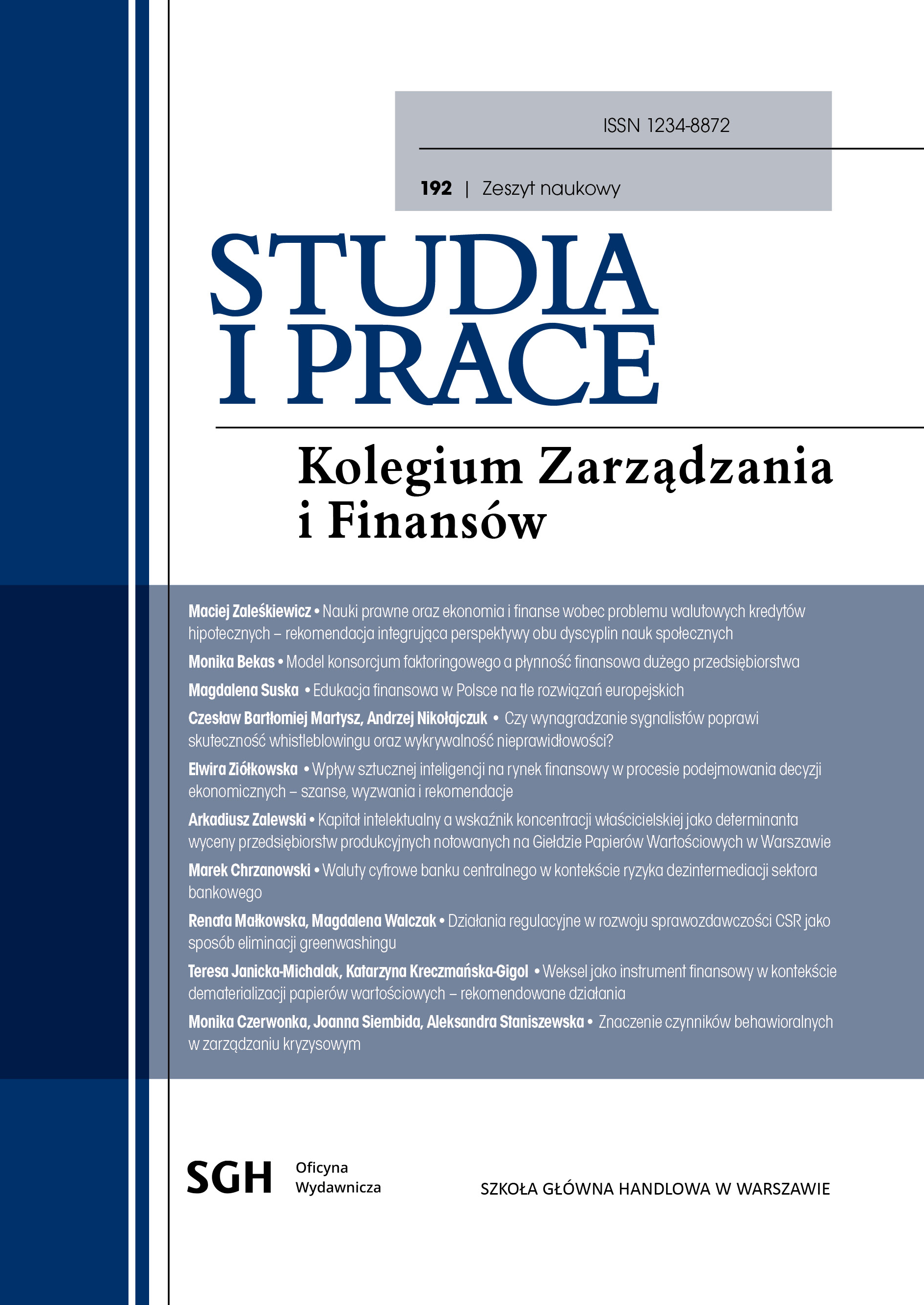Financial education in Poland as compared to European solutions
DOI:
https://doi.org/10.33119/SIP.2023.192.3Keywords:
financial education, financial competencies, state financial education strategies, EU member states, Poland, financial inclusionAbstract
The dynamic development of financial products and services as well as changes and crises in financial markets illustrate how important financial knowledge and its practical application are to society. The financial awareness and competencies of citizens are currently significant determinants of financial market development. They are strongly linked to the financial behaviours of society and the outcomes such behaviours can lead to. Only consumers who are aware of the possibilities and risks will be able to fully benefit from the innovative solutions offered by the modern financial services market, choosing products that best meet their specific needs. The aim of this study is to present the level of financial education, financial competencies, and financial inclusion in Poland in comparison to other European countries. The research is complemented by an analysis of the educational offer in the field of financial education at Polish higher education institutions, particularly at SGH Warsaw School of Economics (SGH).It has been observed that the financial knowledge and skills of Poles are relatively low as compared to other European Union (EU) countries. It has been noted that Polish society is not adequately prepared to make optimal financial and economic decisions, and the increasingly sophisticated offers, which are a strategic response to growing competition in financial markets, overwhelm consumers with a variety of products and services. Furthermore, it has been established that a high level of financial competencies not only allows for individual benefits but also has social and overall economic advantages. In this study, a comparative analysis method as well as descriptive and statistical analysis have been applied.
Downloads
References
1. Ustawa z dnia 19 sierpnia 2011 r. o usługach płatniczych (t.j. Dz.U. 2022 poz. 2360).
Wydawnictwa zwarte
1. Anderloni, L., Braga, M. D., Carluccino, E. M. (2007). New Frontiers in Banking Services. Emerging Needs and Tailored Products for Untapped Markets. Berlin–Heidelberg: Springer.
2. Cwynar, A. (2021). Alfabetyzm finansowy na świecie i w Polsce. Warszawa: PWE.
3. Dąbrowska, A., Janoś-Kresło, M., Oziomek, I. (2005). Ochrona i edukacja konsumentów we współczesnej gospodarce rynkowej. Warszawa: PWE.
4. Frączek, B. (2014). Niski poziom alfabetyzacji finansowej społeczeństwa jako bariera ograniczająca rozwój rynku kapitałowego. W: Rynek kapitałowy wobec wyzwań dekoniunktury ,T. Czerwińska, A. Nowak (red.). Warszawa: Wydawnictwo Naukowe Wydziału Zarządzania Uniwersytetu Warszawskiego.
5. Global Findex Database (2021). Financial Inclusion, Digital Payments and Resilience in theAge of COVID-19. Washington: World Bank.
6. Iwanicz-Drozdowska, M. (2011). Edukacja i świadomość finansowa. Warszawa: Oficyna Wydawnicza SGH.
7. OECD (2005a). Improving Financial Literacy. Analysis of Issues and Policies. Paris: OECD Publishing.
8. OECD (2005b). Recommendation on Principles and Good Practices for Fiancial Education andAwareness. July.
9. OECD (2022). Financial Literacy in Poland: Relevance, Evidence and Provision.
10. OECD/INFE (2013). Financial Literacy and Inclusion. Results of OECD/INFE Survey across Countries and by Gender, Financial Literacy and Education Russia Trust Fund.
11. OECD/INFE (2015). Toolkit for Measuring Financial Literacy and Financial Inclusion.
12. OECD/INFE (2016). International Survey of Adult Financial Literacy Competencies.
13. OECD/INFE (2020). International Survey of Adult Financial Literacy.
14. Suska, M. (2022). E-Commerce; The Pillar of the Digital Economy. W: The European UnionDigital Single Market; Europe’s Digital Transformation, Ł. Dąbrowski, M. Suska (Eds.). London–New York: Routledge.
15. Świecka, B. (2016). Wiedza i edukacja finansowa gospodarstw domowych jako determinanty rozwoju obrotu bezgotówkowego. W: Obrót bezgotówkowy w Polsce – stan i perspektywy, P. Bolibok, M. Żukowski (red.). Lublin: Wydawnictwo KUL.
Artykuły prasowe i okolicznościowe
1. Ambuehl, S., Bernheim, B., Lusardi, A. (2014). Financial Education, Financial Competence and Consumer Welfare, Global Financial Literacy Excellence Center Working Paper Series, 2014–4.
2. Batsaikhan, U., Demertzis, M. (2018). Financial Literacy and Inclusive Growth in the European Union, Policy Contribution, 8.
3. Hastings, J. S., Madrian, B. C., Skimmyhorn, W. L. (2013). Financial Literacy, Financial Education, and Economic Outcomes, Annual Review of Economics, 5, s. 347–373.
4. Knehans-Olejnik, A. (2014). Rola edukacji finansowej w racjonalizowaniu zachowań konsumentów, Handel Wewnętrzny, 3 (350), s. 255–273.
5. Lusardi, A. (2019). Financial Literacy and the Need for Financial Education: Evidence and Implications, Swiss Journal of Economics Statistics, 155 (1).
6. Lusardi, A., Mitchell, O. (2014). The Economic Importance of Financial Literacy: Theory and Evidence, Journal of Economic Literature, 52 (1), s. 5–44.
7. Świecka, B. (2018). Kompetencje finansowe i edukacja finansowa. Ujęcie teoretyczne i praktyczne, Journal of Insurance, Finacial Markets and Consumer Protection, 27 (1), s. 3–17.
8. Wagner, J., Walstad, W. B. (2019). The Effects of Financial Education on Short-Term and Long-Term Financial Behaviours, The Journal of Consumer Affairs, 53 (1), s. 234–259.
Materiały internetowe
1. CFI (2023). Financial Inclusion, https://corporatefinanceinstitute.com/resources/economics/financial-inclusion/ (dostęp: 25.04.2023).
2. CGAP (2023). Financial Inclusion, https://www.cgap.org/financial-inclusion (dostęp:25.04.2023).
3. CNMV (2018). Financial Education Plan 2018–2021, http://www.cnmv.es/DocPortal/Publicaciones/PlanEducacion/PlanEducacion18_21en.pdf (dostęp: 25.04.2023).
4. CSSF (2020). Financial Education, https://www.cssf.lu/en/financial-education/ (dostęp:25.04.2023).
5. Eurostat (2022). Individulas – Internet Activities, https://ec.europa.eu/eurostat/databrowser/view/ISOC_CI_AC_I/default/table?lang=en (dostęp: 25.04.2023).
6. Kotkowski, R., Dulinicz, M., Maciejewski, K. (2021). Zwyczaje płatnicze w Polsce w 2020 r.,
https://www.nbp.pl/systemplatniczy/zwyczaje_platnicze/zwyczaje_platnicze_Polakow_2020p.pdf (dostęp: 25.04.2023).
7. Obserwator Finansowy (2022). Ruszyła Akademia NBP, https://www.obserwatorfinansowy.
pl/bez-kategorii/rotator/ruszyla-akademia-nbp/ (dostęp: 25.04.2023).
8. OECD (2021). A National Financial Literacy Strategy for Austria, https://www.oecd.org/daf/fin/financial-education/A-national-financial-literacy-strategy-for-austria.pdf (dostęp: 25.04.2023).
9. Quello che conta (2023). Strategia nazionale, https://www.quellocheconta.gov.it/it/chi-siamo/
strategia-nazionale/ (dostęp: 25.04.2023).
10. Republic of Bulgaria (2023). National Strategy for Financial Literacy and Its Action Plan (2021–2025), https://www.minfin.bg/en/1491 (dostęp: 24.04.2023).
11. Rzecznik Finansowy (2022). Krajowa Strategia Edukacji Finansowej. Publikacja raportu „Znajomość zagadnień finansowych w Polsce – znaczenie, dane i oferta edukacyjna”, https://rf.gov.
pl/2022/11/18/krajowa-strategia-edukacji-finansowej/ (dostęp: 25.04.2023).
12. Todos Contam (2023). Orientações estratégicas, https://www.todoscontam.pt/pt-pt/orientacoes-estrategicas (dostęp: 25.04.2023).
13. World Bank (2022). Financial Inclusion, https://www.worldbank.org/en/topic/financialinclusion/overview (dostęp: 25.04.2023).









